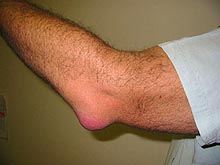| Home A B C D E F G H I J K L M N O P Q R S T U V W X Y Z |
|
Home |
Bursitis Treatment: Tips to Relieve
|
||
Reaching for canned goods on high shelves in the supermarket did not always make you wince. But now, raising your arms to retrieve a can of beans or box of pasta is an exercise in pain and you are considering trading in shopping carts for take-out menus. Think your aching shoulder may be signalling the first twinges of arthritis? Think again, you may have bursitis. Bursitis is different from arthritis, although people often confuse the two because the pain can be so similar. In bursitis, the fluid-filled sacs that cushion the joints become inflamed, most commonly from overuse. The usual symptoms of bursitis are redness, swelling, and tenderness. Only the doctor can tell you for sure whether you have bursitis or arthritis. But if you have had it before, you will recognize a flare-up again because of the pain.

Bursitis attacks the shoulder more often than any other part of the body, courtesy of a lifetime of playing golf or tennis, raking leaves, and washing the car. The shoulder bursa just wears out, much like an old fan belt. Chronic bursitis in the shoulder can develop into frozen shoulder, a condition in which the shoulder becomes virtually immobile. Bursitis can also flare up in the knee, hip, and elbow.
Try ice. Wrap an ice pack in a towel and apply it to your sore shoulder or knee up to 20 minutes at a time, up to three times a day. You might use an elastic bandage to keep the pack in place.
Avoid heat. Do not apply heat for the first few days, since it will aggravate the swelling. After that, however, you may want to use a warm compress or a heating pad set on "low" to ease the pain.
Ease the ache with Arnica. After you ice the affected area, rub on some Arnica. This homeopathy remedy, which you apply directly to your skin, is used to reduce swelling and muscle soreness. You will find Arnica in health food stores or wherever homeopathic remedies are sold.
Massage away the pain. Gently massage the sore area to loosen the tissue. Be careful not to press too hard or too deep.
Take aspirin. Reduce the pain and swelling with an over-the-counter nonsteroidal anti-inflammatory drug (NSAID) such as aspirin. Avoid aspirin and other NSAIDs, however, if you have gastrointestinal problems or a bleeding condition.
While you should avoid activities that will put undue strain on your shoulder during a flare-up of bursitis, it is crucial to keep that shoulder supple. A bursitis-ridden shoulder is much like a door hinge. With neglect, the joint gets rusty and creaky. This gentle range-of-motion exercise can help build your shoulder's strength and preserve its flexibility. Put three 1-pound cans into a plastic bag. Stand at a counter and bend at the wrist, placing your good arm on the countertop and cradling your head in the crook of that arm. Holding the bag of cans with your other hand, dangle your painful arm toward the floor and slowly move your arm in a circle. This exercise will pull your arm from beneath the bursa. Doing this regularly will help prevent the bursitis from getting worse.
Raymond Lee Geok Seng is one of the foremost experts in the health and fitness industry and is a writer specializing in body health, muscle development and dieting. He has spent countless of time and efforts conducting research and share his insightful and powerful secrets to benefit men and women all over the world. He is currently the author of the latest edition of "Neck Exercises and Workouts." Visit http://www.bodyfixes.com for more information.
|
Glossary References Links Contact
|